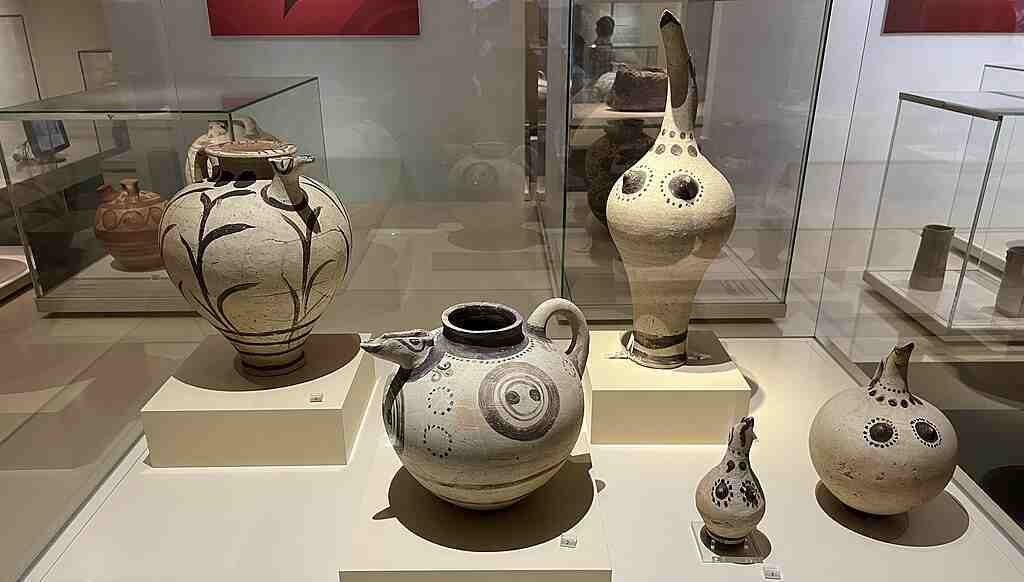Ancient Greek Ceramics
The ancient Greek ceramics, from 1000 to 400 BC. circa AD, provides not only some of the most characteristic vase shapes of antiquity, but also some of the oldest and most diverse depictions of ancient Greek cultural beliefs and practices. Moreover, ceramics is, with its durability (even when broken) and its lack of appeal to treasure hunters, one of the great survivors of archaeology.
In antiquity, especially in Greece and Rome, great use was made of containers of all sizes and shapes, meeting all needs, made of ceramic.
It is therefore a valuable tool for archaeologists and historians in determining the chronology of ancient Greece. Regardless of their artistic and historical value, the vast majority of Greek vases, despite being dusty museum pieces today, were in fact intended for everyday use. To paraphrase Arthur Lane, it is perhaps good to remember that, lying on stone pavement and wet, they must have once shone in the Mediterranean sun.
Large Jug with polychrome bird collection. The highly decorative composition and liveliness of the stylized birds are particulary impressive. Photo taken in the National Museum of Archaeology in Athens, Greece. Pinterpandai.com, CC BY-SA 3.0, via Wikimedia Commons
Uses
We can group the different Greek vases into several categories:
1. Transport vessels:
- amphora (liquids, especially olive oil), variants: Panathenaic amphora (rewarding the winners of the Panathenaic events) and pelike,
- hydria, used to carry water from the well;
2. Storage vessels:
- pithos, used to store wine, oil, cereals…
- crater, used to mix water and wine, where the wine is drawn using an oinochoe or an olpè,
psykter, used to refresh wine during banquets; - the stamnos used to store wine
3. Drinking vessels:
- kylix, common cup,
- skyphos, tall goblet,
- kantharos with large basin, attribute of Dionysos,
- rhyton, drinking horn;
4. Bowls:
- aryballos, alabaster and lekythos, containing fragrant oils,
- pyxis, make-up pot,
- lebes, ritual vase of marriage,
- loutrophore, used to transport water for the nuptial bath or the funeral toilet.
This is a modern typology, rigidified for convenience of description. In reality, the name given today to a vase does not necessarily correspond to the name given to it by the Greeks: a lekythos could very well be qualified as an aryballos.
Similarly, a vase was not limited to a specific use: an amphora could carry much more than a liquid. Finally, potters often made plastic vases, partly adopting a human, animal or plant form.

Forms of Greek ceramics: (1a-b) amphora; (2a-d) hydria; (3) stamnos; (4) krossos; (5) Panathenaic amphora; (6) oinochoe; (7) pelike; (8) lekanis; (9) kélébé; (10) crater; (11) karceison; (12) kantharos; (13) kylix; (14) acetabulum; (15) kyathos; (16) kg; (17) rhyton; (18) askos (Herman Weis, History of culture. Ancient Greece, Moscow, 1903). Photo credit: Hermann Weiss (1822-1897), Public domain, via Wikimedia Commons
Descriptions
Alabaster
The alabaster is one with an elongated body and a narrow neck, often made of stone (alabaster), containing a balm or a perfume. The flat disc-shaped mouthpiece was used to spread the product on the skin. It was used by athletes to coat their bodies, or by women to perfume themselves.
Amphora
The best-known vase from antiquity, the amphora has an oblong shape, with a narrow point at the base, or a foot. The amphorae with spikes were intended for transport over long distances, the spike facilitating handling, and allowing head-to-tail storage in the holds of ships.
The amphorae have a narrow neck, an ovoid body, and two handles. They are intended for the storage and transport of liquids (wine, oil) or grains.
In Rome as in Greece, the amphora was a unit of measurement, worth 19.65 liters (5.19 gallons) in Athens and 26.26 liters (6.93 gallons) in Rome, which kept a standard in the Capitol.
Aryballos
The aryballos is a vase used to store perfumed oil intended for body care.
Cantharus
The kantharos is a semi-deep cup, with two handles, used to drink wine, and linked to the Dionysian cult. They are usually highly decorated….
Crater
The krater is a vase with a large body, an open neck, and two small handles. There were many kinds. It was used for mixing water and wine at banquets. The Vix Krater is the largest known Greek bronze vessel. It was discovered in the Tomb of Vix, the burial place of a Celtic princess in France at Vix.
The column krater is a variant of the krater developed in Corinth during the Orientalizing period.
Dolium
The dolium (pl. dolia) is a very large vase, which can reach 1,200 litres. It was used as a cistern for wine, water, oil or for storing cereals, and was sometimes buried as a buried attic (cf. archaeological site of Ensérune, near Béziers). Once in place, the dolia could not be moved: you had to tap into them to empty them.
Hydria
The hydria is a vase with a wide body and a narrow neck, with two or four handles. It was used to draw water, and to transport it to the home. Women of antiquity are often represented with a hydria on their shoulders or heads.
Kandelas
This section is empty, insufficiently detailed or incomplete. Your help is welcome ! How to do ?
Kernos
Vase comprising several receptacles joined together, with a ritual function.
Cyathe or Kyathos
Cup with a high vertical handle used to draw wine from the crater.
Kylix
Drinking cup with two opposite horizontal handles.
Lagynos
Pot-bellied containers, with a handle and a long neck that tapers slightly towards the end of the neck; thanks to their flat base, it is possible to place them
Lebes
The lébès is an ample vase with a round bottom placed on a high support, used in the wedding ritual. See also Dinos, a similar shape for mixing water and wine.
Lekythos
The lekythos is a very slender vase with a single handle, containing perfumed oils.
Loutrophorus
The loutrophore is a very slender vase with two handles, most often containing water, used for nuptial and funeral rites…
Oinochoe
The oinochoe is a vase with a single handle, a wide belly, a three-lobed spout. He was serving wine.
Olpe
The olpé is a pear-shaped jug (pear-shaped) whose slender neck flares out like a trumpet.
Pelike
Bellied vase with two vertical handles.
Psykter
Slender vase with a spherical top which was used to cool wine.
Pyxis
The pyxis or pyxis is a small round vase, with a flat bottom (sometimes pointed in the Geometric period, when holes made it possible to suspend it), and generally equipped with a lid. It serves as a box or jewelry box. The Middle Ages made it a host box.
Skyphos
It is a goblet, that is to say a type of drinking vessel 5 to 15 cm (1.96 to 5.9 inches) high, usually without feet.
Shapes of Attic Vases from 6th to 4th BC. Pinterpandai.com, CC BY-SA 3.0, via Wikimedia Commons
Black-figure pottery from Attica
Attic black-figure pottery designates a production of pottery from Athens and its region, between the beginning of the seventh century and the end of the sixth century BC. It is roughly followed by Attic red-figure pottery.
Name vase by the Nessos Painter. Attic black-figure pottery with the scene on the neck shows Heracles stabbing Nessos. The scene on the belly shows events associated with Perseus. C. 620/610 BC, now in the Athens National Archaeological Museum. Nessos Painter, CC BY-SA 3.0, via Wikimedia Commons
In this technique, the figures stood out in black against a light background. The background color was either the natural one of the clay used, or that of a clear engobe.
The black tint was revealed during the reduction firing of the piece.
Sources: PinterPandai, World History, Britannica, Art In Context
Photo credit (main picture): PinterPandai (CC BY-SA 4.0) via Wikimedia Commons
Photo description: 1. Spouted terracotta pithoid jar with reed decoration.
2. Spouted terracotta pithoid jar with circles.
3. Minoan clay polychrome beak-spouted nippled ewers, with humain and bird features; both plastic and painted. The dots on the neck represent necklaces. A characteristic Theran pottery type 16th Century BCE, used for libations (an act of pouring a liquid as a sacrifice, as to a deity).
Photo taken in the National Museum of Archaeology in Athens, Greece.



